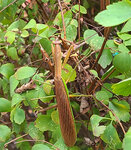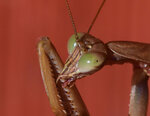, 0°
Wind: mph
On the 8th of October, I was up on a ladder, checking a faulty floodlight on the side of a building. I happened to look down at a bush in a nearby garden and saw something unusual.
I …
Stay informed about your community and support local independent journalism.
Subscribe to The River Reporter today. click here
This item is available in full to subscribers.
Please log in to continue |


On the 8th of October, I was up on a ladder, checking a faulty floodlight on the side of a building. I happened to look down at a bush in a nearby garden and saw something unusual.
I climbed down the ladder and took a look to see what stood out on the bush. What I found was a brown-colored praying mantis It was a Chinese mantis, the largest of four mantis species found in this area. It was about five inches long, making it one of the larger insects that you will spot this year.
Out of the four species of mantids found in the area, only the Carolina mantis is native, and it is not commonly seen compared to the Chinese mantis.
Mantises are very small when they hatch; the nymphs are smaller than a fingernail. They gradually get larger, going through seven to nine molts (or instars) through the season. They develop wings and grow into adulthood during the summer. The wings allow for short flights; the flights are largely to escape threats or to move to a more promising hunting area, not to catch prey in mid-air as, for instance, a dragonfly would do.
The real strength of a mantis when it comes to capturing prey is its ability to stay motionless for long periods of time, blending in with its surroundings as it waits for prey to pass close to it. When a prey insect gets close enough, it grabs the prey with its spiny and powerful forelegs very quickly. This grab, from start to finish, takes about 1/20th of a second.
The diet of the praying mantis includes grasshoppers and locusts, and some have even been spotted taking spotted lanternflies.
The negative side to their dietary habits is that larger mantises, mainly the Chinese mantis, will predate beneficial pollinators such as bees and butterflies.
It was about 60 degrees Fahrenheit when I saw the mantis this month—a little late, as mating and egg-laying is usually done by mid-to-late September. However, it has been a mild fall except for the last week or so, and mantises still around will likely survive until the first hard frost. Mantises lay egg masses, or ootheca, in shrubs and bushes. The eggs overwinter, and then hatch the following spring
Comments
No comments on this item Please log in to comment by clicking here